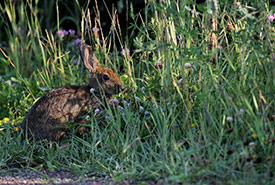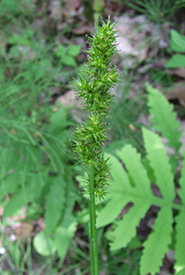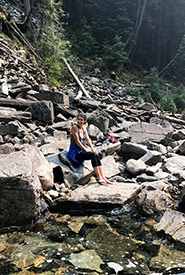Bring on the alternative lawns!

A cottontail among a red clover and black medic clover patch (Photo by Mike Dembeck)
Weeds: What are they? Unwanted, non-traditional turf? But what if there was something more to all those pesky patches of plants?
For some, there’s nothing more satisfying than a healthy lawn full of lush, green grass. For others, like myself, grass lawns seem pointless. Why would I waste my time looking after pointy plants that do nothing but eat up resources all day? In my spitefulness toward grass turf, I came across the concept of alternative lawns: layers of diverse ground cover that promise environmental, economic and aesthetic benefits, including reduced care, to the lawn owner. How revolutionary!
Related blog posts
As I went down the alternative rabbit hole, I learned that once the new lawn has been established, a wide variety of plants, such as mosses, sedges, clovers and other wildflowers can essentially take care of themselves. Not all kinds of plants, however, are suitable for all kinds of Canadian landscapes. It’s essential to keep in mind which plant species are native and non-native to your area.

Awl-fruited sedge (Photo by Brenda van Sleeuwen)
Once upon a time, sedges, clovers and other plants were accepted, even encouraged, as a part of the diverse flora that made up a healthy, happy lawn. Then came along the idea that anything other than lush, green grass made yards impure and ultimately undesirable. The fact remains that alternative vegetation was, at one point, promoted in lawn care routines, and for good reason!
Clovers are what’s known as nitrogen-fixators: they take nitrogen out of the air and mix it into the soil to fertilize themselves, staying lush and green all summer long. On the other hand, several species of sedges are drought resistant, saving you money on those water bills. Many small flowers found growing on lawns anyway, such as dandelions, attract pollinators and support local butterfly populations as well.
Mosses and clovers can be pretty low-growing, too, saving you from crawling back to that cursed lawn mower. While they don’t particularly need maintenance, mosses tend to thrive only in moist areas. So, if you live in the Prairies, that might not be the best option for you. If you’re near the coast, however, that’s a whole different story!
Even if the beauty of convenience, in addition to saving water and fertilizer, doesn’t appeal to you, these unique lawns can be a sight to see in the summertime. Colourful butterflies, buzzing bees and hungry birds create a bustling spectacle of life. Consider planting some widespread, native plants like the awl-fruited sedge, golden ragged moss and common blue violet to get you started. Often, these plants will show up on their own! These alternatives are resilient to different stressors in their own ways, making them great ground-cover options for each province or territory’s distinct environment. At the end of the day, whether it’s supporting local wildlife, conserving water and fertilizer, or retiring lawn mowers, all I really want is to turn turf terrific!
The Conservation Internship Program is funded in part by the Government of Canada’s Summer Work Experience program.


